Numerical Investigation of the Influence of Roof-Cutting Parameters on the Stability of Top Coal Gob-Side Entry Retaining by Roof Pre-Fracturing in Ultra-Thick Coal Seam
Abstract
1. Introduction
2. Field Practice of 100602 Top Coal Gob-Side Entry Retaining
2.1. Production Geology
2.2. Gob-Side Entry Retaining Technology
- (1)
- Within 80 m of the advance working face, the designed roof support parameters are used to make up the constant resistance large deformation anchor cable and reinforcement anchor cable to reinforce the roof and improve its pressure-bearing capacity, so as to lay the foundation for resisting the stress disturbance in the process of advance presplitting blasting and coal mining. The anchor cable should be long enough to reach the solid rock layer and produce a stable anchoring effect.
- (2)
- Within 60 m of the advance working face, the equipment is used to set up the presplitting drill holes on the roof according to the design angle, ensuring that all holes are in the same plane during the drilling process. Then, the explosives are placed in the cavity pipe and into the drill holes, and are finally detonated and form joint-cutting. The roof of the goaf side is more likely to collapse under the influence of mining pressure after slitting while cutting off the stress transmission path and weakening the stress of the roadway surrounding rock.
- (3)
- During mining, retractable U-shaped steel and metal mesh for gangue support are settled up within 6 meters behind the working face, so that the gangue fills the goaf and form a wall with a certain strength. In addition, a hydraulic pillar with a π beam is set up to strengthen the roof support, inhibit the roof on the side of the goaf sinking, reduce the bending moment on the roof, and enhance the stability of the roadway.
- (4)
- Under the support of the blocking gangue structure, the collapsed gangue in the goaf is gradually compacted, the main roof subsidence is contained, and the intense quarry stress caused by it is weakened. The surrounding rock of the lagging working face enters the stable state; then, some temporary support equipment is withdrawn and concrete is sprayed on the gangue wall surface to prevent ventilation leakage in the goaf, and the final gob-side entry retaining is complete.
2.3. Roof-Cutting Technology
- (1)
- Shaped charge technology
- (1)
- After reinforcing with the anchor cable, a two-way energy-concentrating tensile blasting hole is constructed 60 m ahead of the working face using design parameters. This forms a roof-cutting and pressure-relief presplit cut suture over a 30 m range.
- (2)
- The two-way energy-gathering tube, constructed from special energy-gathering PVC, measures 42 mm in outer diameter, 36 mm in inner diameter, and 1500 mm in length. A detonator is placed in each blast hole, charged forwards, and connected in series. Blast holes are initially designed to be 10 m deep, with the final depth determined on-site.
- (3)
- Concentrated energy blasting employs grade 3 emulsion explosives, using 2~4 rolls of 32 mm × 300 mm powder per tube. The sealing hole length is at least 2.5 m, using bentonite gun mud for sealing.
- (4)
- Considering on-site construction convenience, the distance between the drilling rigs is 3.8 m, and between the blast holes is 760 mm (500 mm if the hole depth is less than 8 m).
- (5)
- Accurate directional presplitting blasting on the roof employs energy-concentrating tube uncoupling and charging, tested using five methods. The charging structure is 4 + 4 + 4 + 2 + 2, with a mud-sealing depth of 2500 mm.
- (6)
- Before mining, energy-focused blasting kerfs are implemented on the gob-side roof, as shown in Figure 5.
- (2)
- Parameter design
3. Numerical Simulation Analysis
3.1. Model Establishment and Simulation Scheme
3.2. Analysis of Displacement Field of Surrounding Rock
3.3. Analysis of Stress Field in Surrounding Rock
4. Top Coal Roadway Support Strategy and Stay Roadway Effect
4.1. Roadway Damage Form and Mechanical Model Analysis
4.2. Roadway Support Strategy
4.3. Effect of the Retention Lane
5. Discussion
6. Conclusions
- (1)
- Based on the geological conditions of the Yitang coal mine, numerical simulation analysis was conducted on top coal gob-side entry retaining, and the influence of various factors on the effectiveness of gob-side entry retaining was explored. The simulation results indicate that under the conditions of a roof-cutting height of 16 m, borehole dip angle of 10°, mining height of 4 m, and an average thickness of 8 m in the coal seam, the roof of the coal seam did not detach and the bending settlement was small. The cantilever beam has good load-bearing capacity, and the overall structure is stable. The rock strata in the goaf collapse completely and the filling condition is good.
- (2)
- During the process of gob-side entry retaining, it was found that the variation pattern of the roof stress under different factors is basically the same, with a peak stress of around 3 MPa. As the roof-cutting height and mining height increase, the stress on the roof gradually decreases; as the borehole dip angle and coal seam thickness increase, the stress on the roof gradually increases.
- (3)
- The mechanical analysis found that the strength of the roof coal beam directly affects the stability of the roadway, and the roof stability is related to the changeable factors such as the thickness of the top coal, the span of the roadway, and the elastic modulus of the coal seam. When increasing the thickness of the top coal appropriately, the elastic modulus of the roof anchorage area is enhanced by using step support, and the span distance is reduced by using reduced span support to enhance the strength of the roof of the coal seam and maintain the stability of the surrounding rock.
- (4)
- The on-site monitoring data of the mine pressure shows that under a reasonable support plan, the maximum subsidence of the roof is 308 mm, and the total convergence of the roadway movement is 280 mm. The total affected area is within 140 m of the lagging working face, and the deformation of surrounding rock is well controlled, achieving certain technical and economic benefits.
Author Contributions
Funding
Data Availability Statement
Conflicts of Interest
Nomenclature
| the roof-cutting height, m | |
| the mining height, m | |
| the thickness of the top coal, m | |
| the roof subsidence displacement, m | |
| the floor heaving displacement, m | |
| the coefficient of rock fragmentation and expansion | |
| the tensile strength of the coal seam roof, MPa | |
| the borehole dip angle, ° | |
| the radius of the borehole, mm | |
| the initial damage to the roof rock | |
| the tensile strength of the roof rock, MPa | |
| the original rock stress, MPa | |
| the explosive blasting decay index | |
| the maximum shockwave pressure of the borehole wall, MPa | |
| the side pressure coefficient | |
| the horizontal direction overburden load, kN/m | |
| the height of the roadway, m | |
| the maximum tensile stress inside the beam structure, MPa | |
| the horizontal structural stress of the beam structure, MPa | |
| the thickness of the beam structure, m | |
| the cross-sectional width of the beam structure, m | |
| the maximum bending moment to which the beam structure is subjected, kN·m | |
| the self-weight of coal beam and overburden load transferred to coal beam, MPa | |
| the moment of inertia discount factor of the laminated beam | |
| the upper load of the laminated beam structure, kN/m | |
| the span of the laminated beam structure, m | |
| the moment of inertia of the laminated beam structure | |
| the cross-sectional width of the laminated beam structure, m | |
| the radius of curvature of the laminated beam structure, m | |
| the modulus of elasticity of the laminated beam structure, MPa |
References
- Wang, K.; Huang, Y.; Gao, H.; Zhai, W.; Qiao, Y.; Li, J.; Ouyang, S.; Li, W. Recovery Technology of Bottom Coal in the Gob-Side Entry of Thick Coal Seam Based on Floor Heave Induced by Narrow Coal Pillar. Energies 2020, 13, 3368. [Google Scholar] [CrossRef]
- Lv, H.; Cheng, Z.; Liu, F. Study on the mechanism of a new fully mechanical mining method for extremely thick coal seam. Int. J. Rock Mech. Min. Sci. 2021, 142, 104788. [Google Scholar] [CrossRef]
- Liu, S.; Yang, K.; Tang, C.; Chi, X. Rupture and Migration Law of Disturbed Overburden during Slicing Mining of Steeply Dipping Thick Coal Seam. Adv. Civ. Eng. 2020, 2020, 8863547. [Google Scholar] [CrossRef]
- Liu, S.; Huang, J.; Huang, Q.; Li, T.; Tang, S.; Liu, X. Floor Pressure-Relief During Top Slice Mining of Extra-Thick Coal Seams and Its Implications for Gas Drainage Application. Geotech. Geol. Eng. 2019, 37, 3113–3125. [Google Scholar] [CrossRef]
- Li, Z.-L.; He, X.-Q.; Dou, L.-M.; Song, D.-Z. Comparison of rockburst occurrence during extraction of thick coal seams using top-coal caving versus slicing mining methods. Can. Geotech. J. 2018, 55, 1433–1450. [Google Scholar] [CrossRef]
- He, W.; He, F.; Zhao, Y. Field and simulation study of the rational coal pillar width in extra-thick coal seams. Energy Sci. Eng. 2019, 8, 627–646. [Google Scholar] [CrossRef]
- Li, X.; Zhao, Y.; He, W.; Li, L.; He, F. Study on Coal Pillar Width and Surrounding Rock Control of Gob-Side Entry in Extra-thick Coal Seam. Geotech. Geol. Eng. 2020, 38, 6855–6868. [Google Scholar] [CrossRef]
- Wang, Q.; Jiang, Z.; Jiang, B.; Gao, H.; Huang, Y.; Zhang, P. Research on an automatic roadway formation method in deep mining areas by roof cutting with high-strength bolt-grouting. Int. J. Rock Mech. Min. Sci. 2020, 128, 104264. [Google Scholar] [CrossRef]
- Çelik, A.; Özçelik, Y. Investigation of the efficiency of longwall top coal caving method applied by forming a face in horizontal thickness of the seam in steeply inclined thick coal seams by using a physical model. Int. J. Rock Mech. Min. Sci. 2021, 148, 104917. [Google Scholar] [CrossRef]
- Liang, Y.; Li, L.; Li, X.; Wang, K.; Chen, J.; Sun, Z.; Yang, X. Study on Roof-Coal Caving Characteristics with Complicated Structure by Fully Mechanized Caving Mining. Shock. Vib. 2019, 2019, 6519213. [Google Scholar] [CrossRef]
- Wang, E.; Xie, S. Determination of coal pillar width for gob-side entry driving in isolated coal face and its control in deep soft-broken coal seam: A case study. Energy Sci. Eng. 2022, 10, 2305–2316. [Google Scholar] [CrossRef]
- Ma, Z.; Chen, C.; Liang, X.; Chen, A.; Song, W. Field and numerical investigation on the stability of coal pillars of gob-side entry driving with top coal. Arab. J. Geosci. 2020, 13, 1193. [Google Scholar] [CrossRef]
- Wang, B.; Dang, F.; Gu, S.; Huang, R.; Miao, Y.; Chao, W. Method for determining the width of protective coal pillar in the pre-driven longwall recovery room considering main roof failure form. Int. J. Rock Mech. Min. Sci. 2020, 130, 104340. [Google Scholar] [CrossRef]
- Chen, A. Width Design of Small Coal Pillar of Gob-Side Entry Driving in Soft Rock Working Face and Its Application of Zaoquan Coal Mine. Adv. Civ. Eng. 2021, 2021, 9999957. [Google Scholar] [CrossRef]
- Qi, F.; Zhou, Y.; Cao, Z.; Zhang, Q.; Li,, N. Width optimization of narrow coal pillar of roadway driving along goaf in fully mechanized top coal caving face. J. Min. Saf. Eng. 2016, 33, 475. [Google Scholar]
- Wang, Y.; Li, Y.; Yu, Z.; Zhang, H.; Ding, D. Research on the Surrounding Rock Control Technology of Gob-Side Entry with a Narrow Coal Pillar Reserved in a Fully Mechanized Caving Face with Large Mining Height. Geotech. Geol. Eng. 2021, 40, 285–300. [Google Scholar] [CrossRef]
- Sakhno, I.; Sakhno, S. Numerical Studies of Floor Heave Control in Deep Mining Roadways with Soft Rocks by the Rock Bolts Reinforcement Technology. Adv. Civ. Eng. 2023, 2023, 2756105. [Google Scholar] [CrossRef]
- Bosikov, I.I.; Martyushev, N.V.; Klyuev, R.V.; Savchenko, I.A.; Kukartsev, V.V.; Kukartsev, V.A.; Tynchenko, Y.A. Modeling and Complex Analysis of the Topology Parameters of Ventilation Networks When Ensuring Fire Safety While Developing Coal and Gas Deposits. Fire 2023, 6, 95. [Google Scholar] [CrossRef]
- Balovtsev, S.; National University of Science and Technology; Skopintseva, O.; Kolikov, K. Misis Aerological risk management in preparation mining of coal mines. Sustain. Dev. Mt. Territ. 2022, 14, 107–116. [Google Scholar] [CrossRef]
- Tian, Z.; Zhang, Z.; Deng, M.; Yan, S.; Bai, J. Gob-Side Entry Retained with Soft Roof, Floor, and Seam in Thin Coal Seams: A Case Study. Sustainability 2020, 12, 1197. [Google Scholar] [CrossRef]
- Xie, S.; Wang, E.; Chen, D.; Li, H.; Jiang, Z.; Yang, H. Stability analysis and control technology of gob-side entry retaining with double roadways by filling with high-water material in gently inclined coal seam. Int. J. Coal Sci. Technol. 2022, 9, 52. [Google Scholar] [CrossRef]
- Cheng, Y.; Jiang, F.; Lin, J.; Chen, Q.; Zhang, D.; Zhang, F. Experimental Study on Gob Side Entry Retaining by Roadside Flexible Packing Under Hard Roof. J. Min. Saf. Eng. 2012, 29, 757. [Google Scholar]
- Zhang, Y.; Wang, X. Modification test of high-water packing material and application in the gob-side entry retained engineering. Arab. J. Geosci. 2022, 15, 579. [Google Scholar] [CrossRef]
- Sun, X.; Li, G.; Song, P.; Miao, C.; Zhao, C.; Li, Q.; Xia, X. Application Research on Gob-Side Entry Retaining Methods in No. 1200 Working Face in Zhongxing Mine. Geotech. Geol. Eng. 2018, 37, 185–200. [Google Scholar] [CrossRef]
- Zhang, X.; Chen, L.; Gao, Y.; Hu, J.; Yang, J.; He, M. Study of An Innovative Approach of Roof Presplitting for Gob-Side Entry Retaining in Longwall Coal Mining. Energies 2019, 12, 3316. [Google Scholar] [CrossRef]
- Zhao, H. State-of-the-art of standing supports for gob-side entry retaining technology in China. J. S. Afr. Inst. Min. Metall. 2019, 119, 891–906. [Google Scholar] [CrossRef]
- Han, C.; Yang, H.; Zhang, N.; Li, X.; Liu, Y.; Liu, W.; Yao, W. Study on Reasonable Coal Pillar Width of Gob-Side Roadway Excavating with Multi-Layer Hard Roof in Western Deep Mine. Geotech. Geol. Eng. 2021, 40, 1417–1428. [Google Scholar] [CrossRef]
- Zhou, X.; Li, H.; Li, X.; Wang, J.; Meng, J.; Li, M.; Mei, C. Research on Gob-Side Entry Retaining Mining of Fully Mechanized Working Face in Steeply Inclined Coal Seam: A Case in Xinqiang Coal Mine. Sustainability 2022, 14, 10330. [Google Scholar] [CrossRef]
- Yang, X.; Sun, Y.; Wang, E.; Mao, W. Study and Application of Gob-Side Entry Retaining Formed by Roof Cutting and Pressure Relief in Medium-Thickness Coal Seam with Hard Roof. Geotech. Geol. Eng. 2020, 38, 3709–3723. [Google Scholar] [CrossRef]
- Wu, H.; Li, Q.; Zhu, C.; He, L. Study on the failure law of surrounding rock in inclined coal seam with gob side entry. Sci. Rep. 2023, 13, 973. [Google Scholar] [CrossRef]
- Ma, X.; He, M.; Wang, J.; Gao, Y.; Zhu, D.; Liu, Y. Mine Strata Pressure Characteristics and Mechanisms in Gob-Side Entry Retention by Roof Cutting under Medium-Thick Coal Seam and Compound Roof Conditions. Energies 2018, 11, 2539. [Google Scholar] [CrossRef]
- Fu, W. Study on Surrounding Rock Control of Gob-Side Entry Retaining in Inclined and Thick Longwall Face. Geotech. Geol. Eng. 2022, 40, 3477–3491. [Google Scholar] [CrossRef]
- Kong, D.; Pu, S.; Cheng, Z.; Wu, G.; Liu, Y. Coordinated deformation mechanism of the top coal and filling body of gob-side entry retaining in a fully mechanized caving face. Int. J. Geomech. 2021, 21, 04021030. [Google Scholar] [CrossRef]
- Wang, H.; Wang, J.; He, M.; Ma, Z.; Tian, X.; Liu, P. A novel non-pillar coal mining technology in longwall top coal caving: A case study. Energy Sci. Eng. 2023, 11, 1822–1841. [Google Scholar] [CrossRef]
- Xie, S.; Wu, Y.; Guo, F.; Zou, H.; Chen, D.; Zhang, X.; Ma, X.; Liu, R.; Wu, C. Application of Pre-Splitting and Roof-Cutting Control Technology in Coal Mining: A Review of Technology. Energies 2022, 15, 6489. [Google Scholar] [CrossRef]
- Wang, Q.; He, M.; Yang, J.; Gao, H.; Jiang, B.; Yu, H. Study of a no-pillar mining technique with automatically formed gob-side entry retaining for longwall mining in coal mines. Int. J. Rock Mech. Min. Sci. 2018, 110, 1–8. [Google Scholar] [CrossRef]
- Ma, Z.; Wang, J.; He, M.; Gao, Y.; Hu, J. Key Technologies and Application Test of an Innovative Noncoal Pillar Mining Approach: A Case Study. Energies 2018, 11, 2853. [Google Scholar] [CrossRef]
- Zhen, E.; Wang, Y.; Yang, J.; He, M. Comparison of the macroscopical stress field distribution characteristics between a novel non-pillar mining technique and two other current methods. Adv. Mech. Eng. 2019, 11, 1687814019850418. [Google Scholar] [CrossRef]
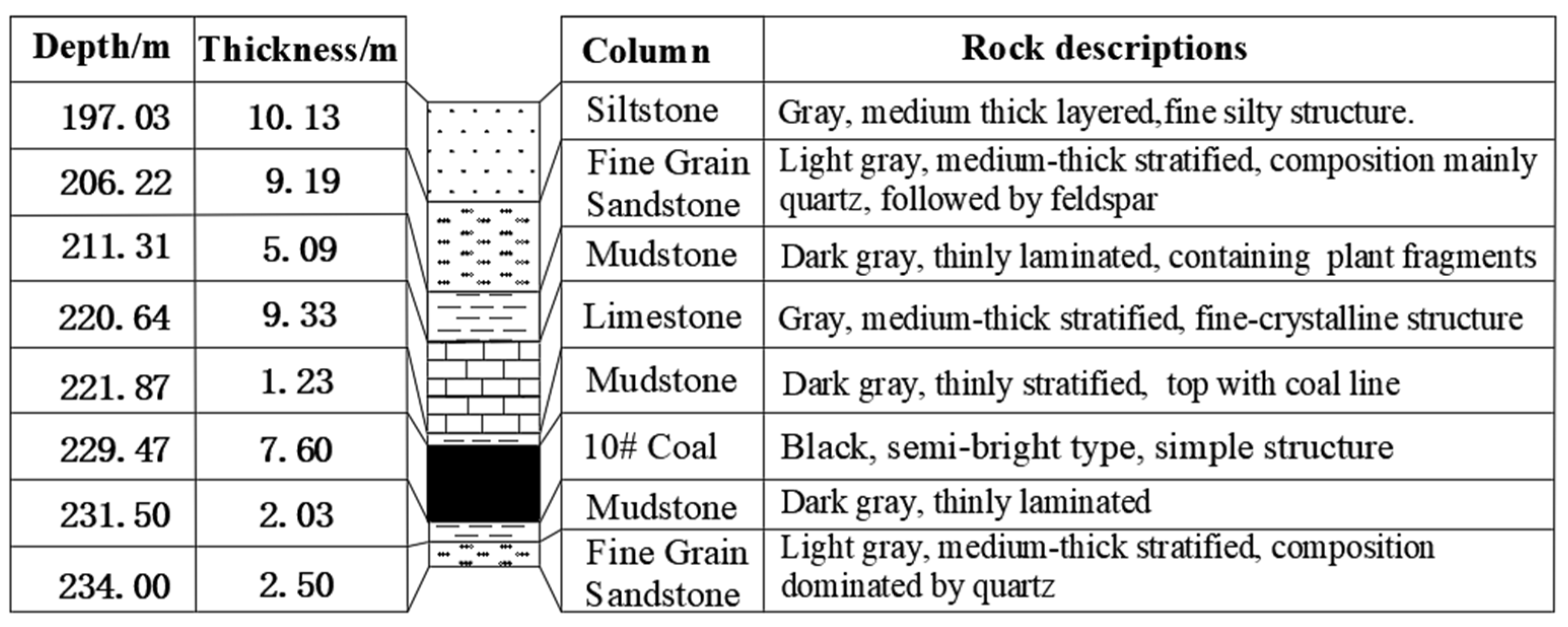
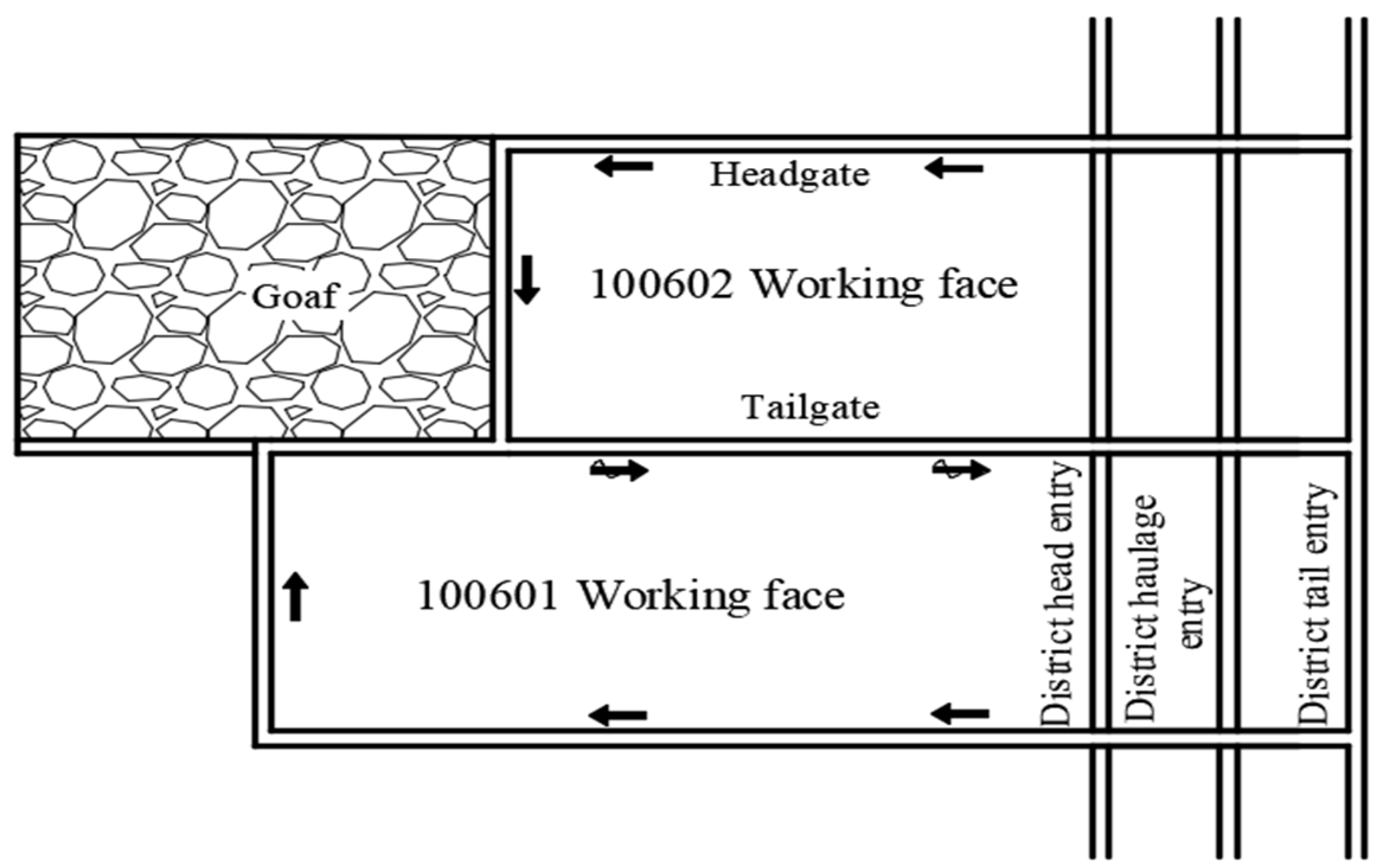

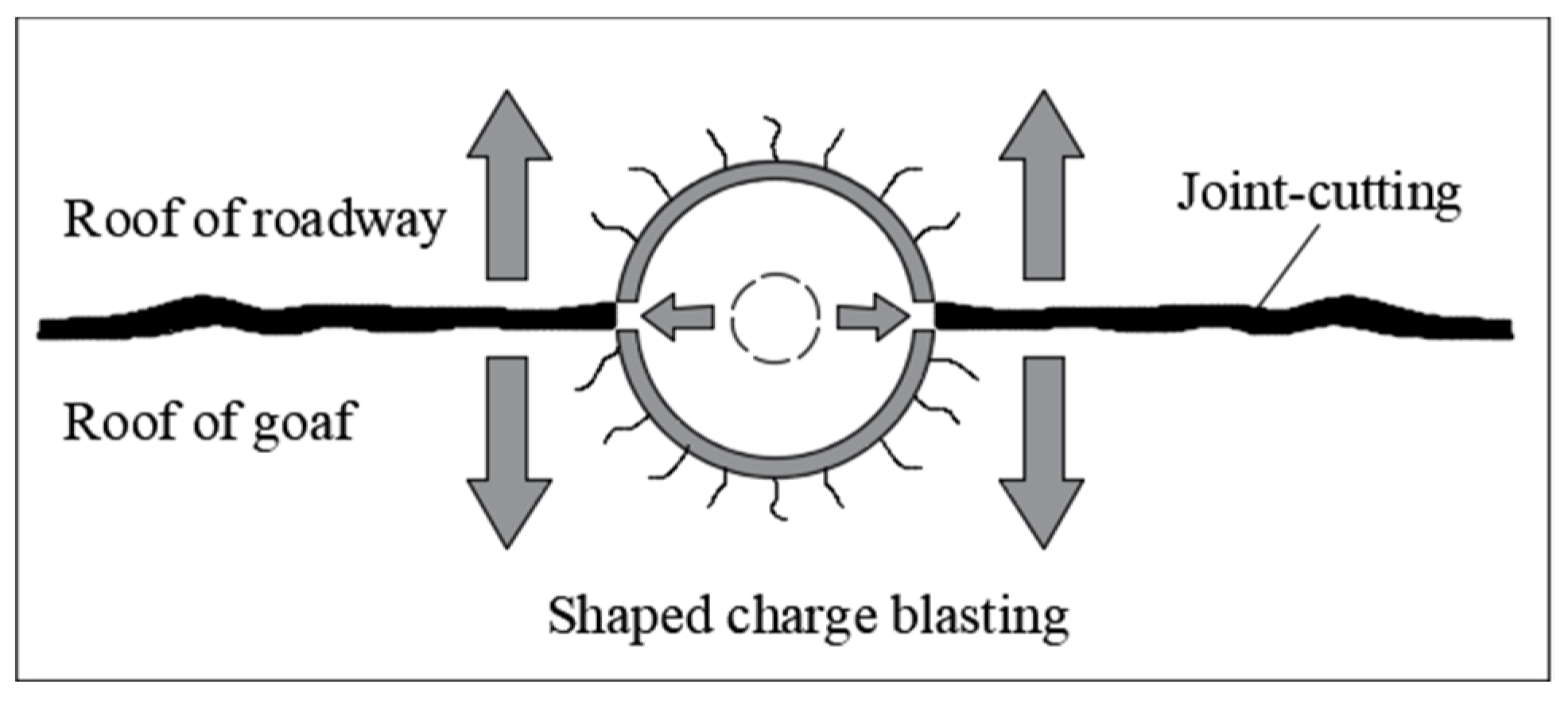
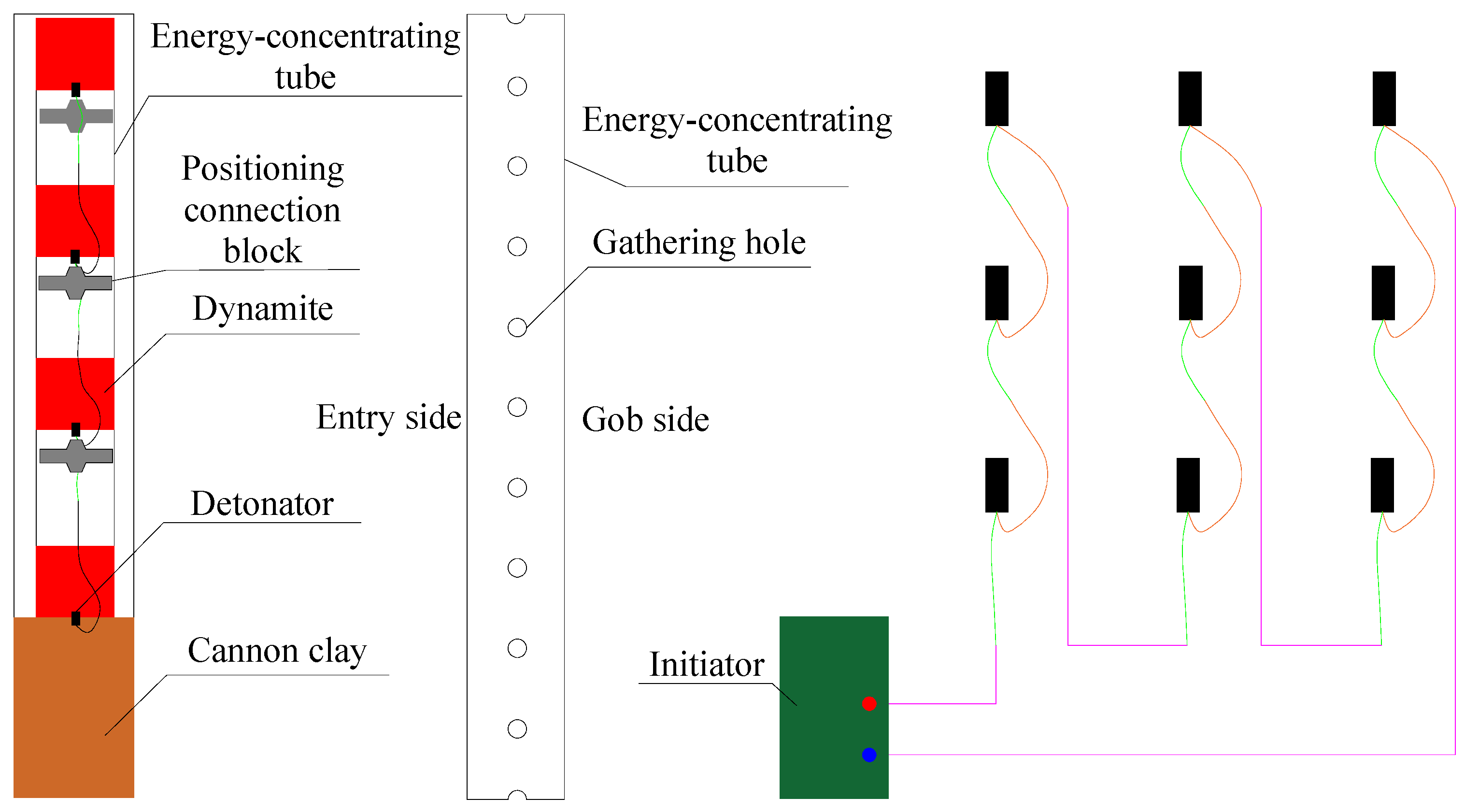

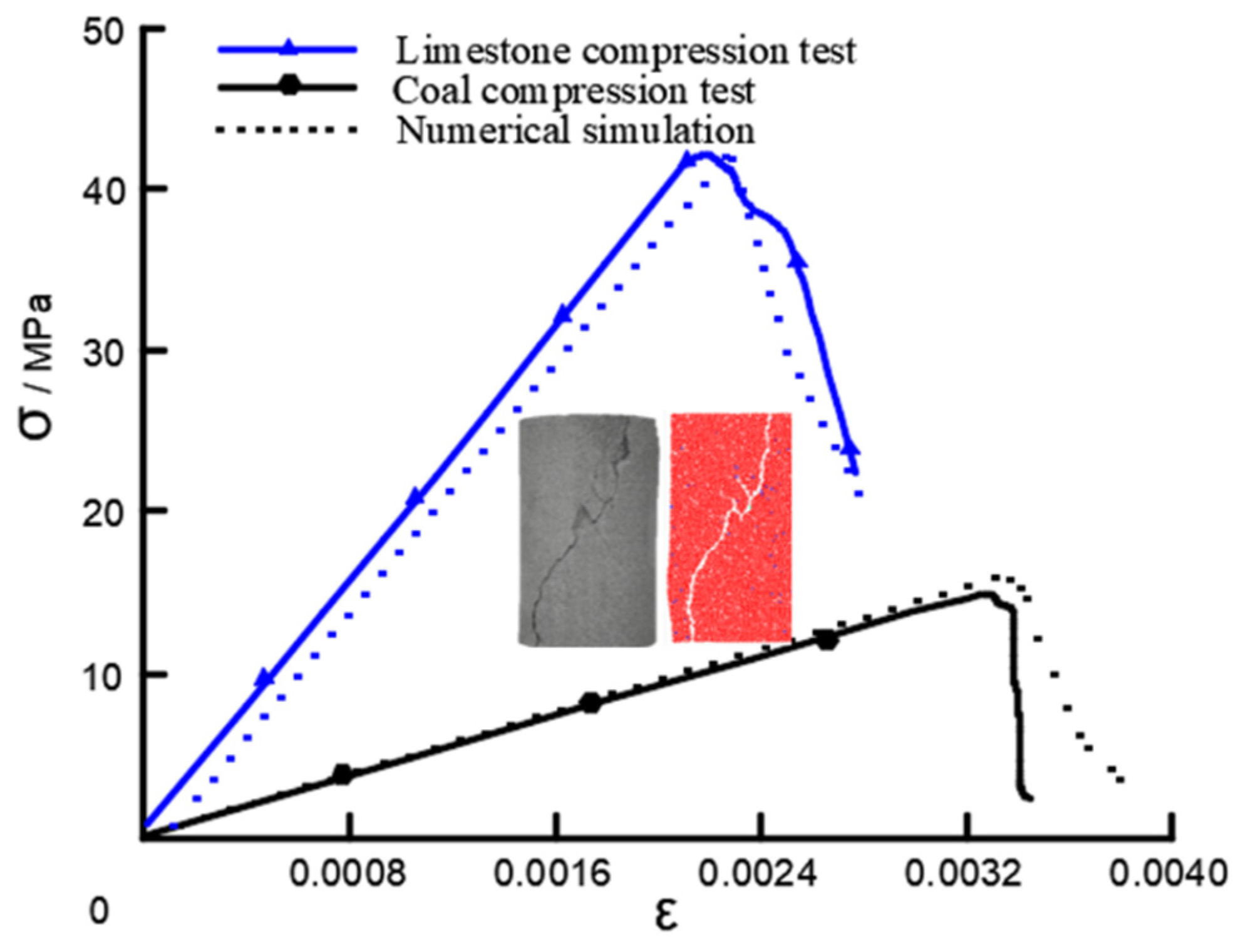



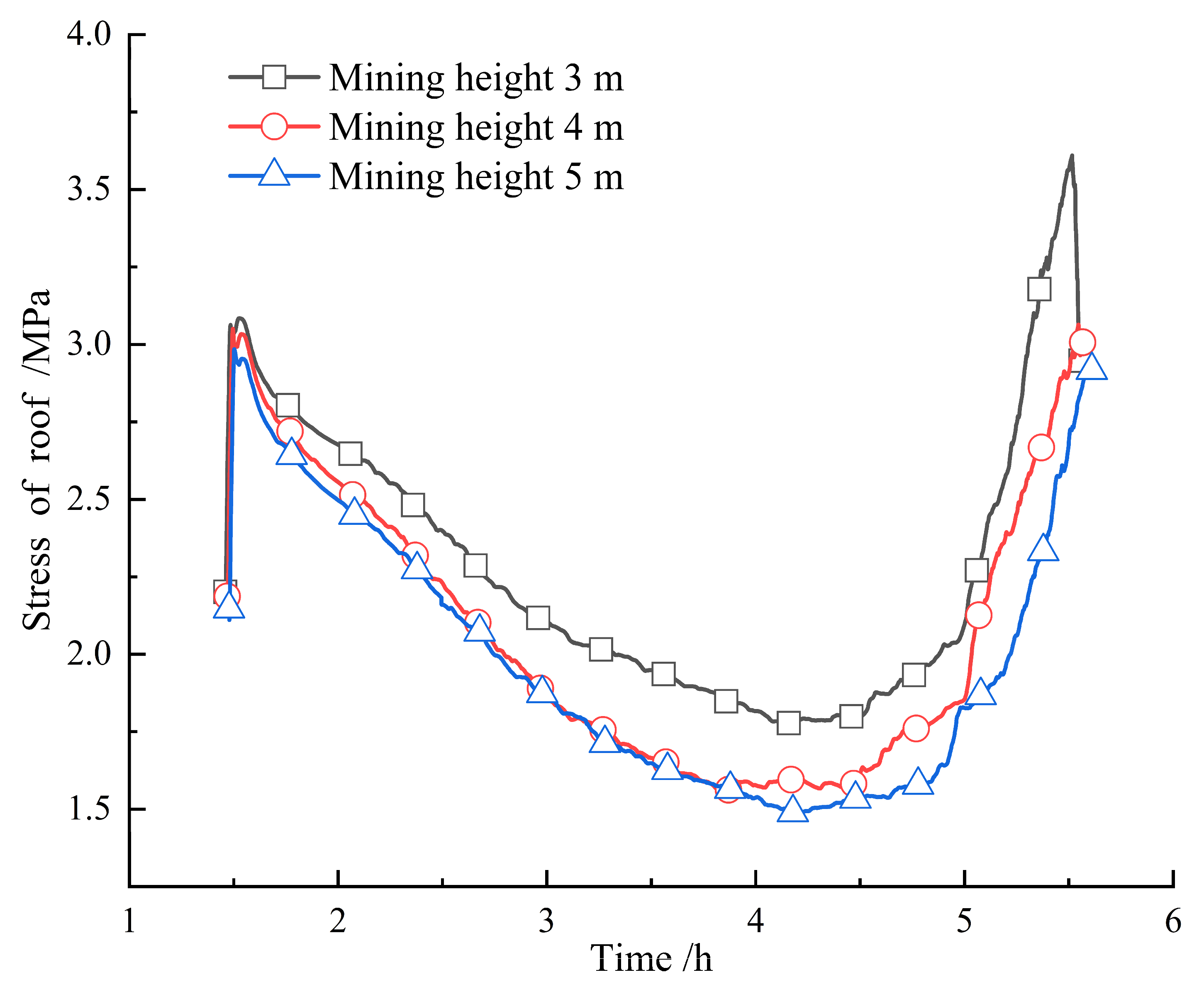
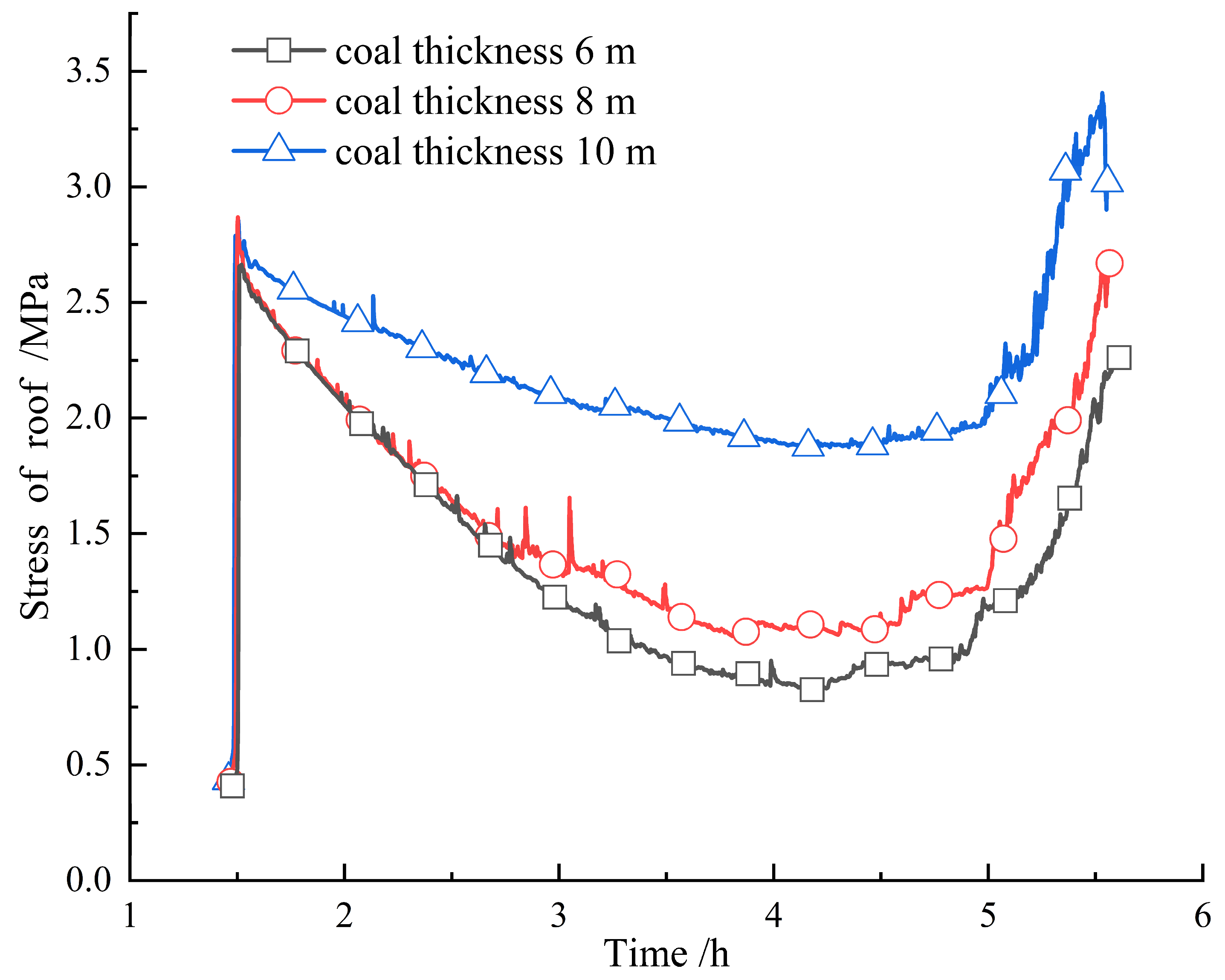
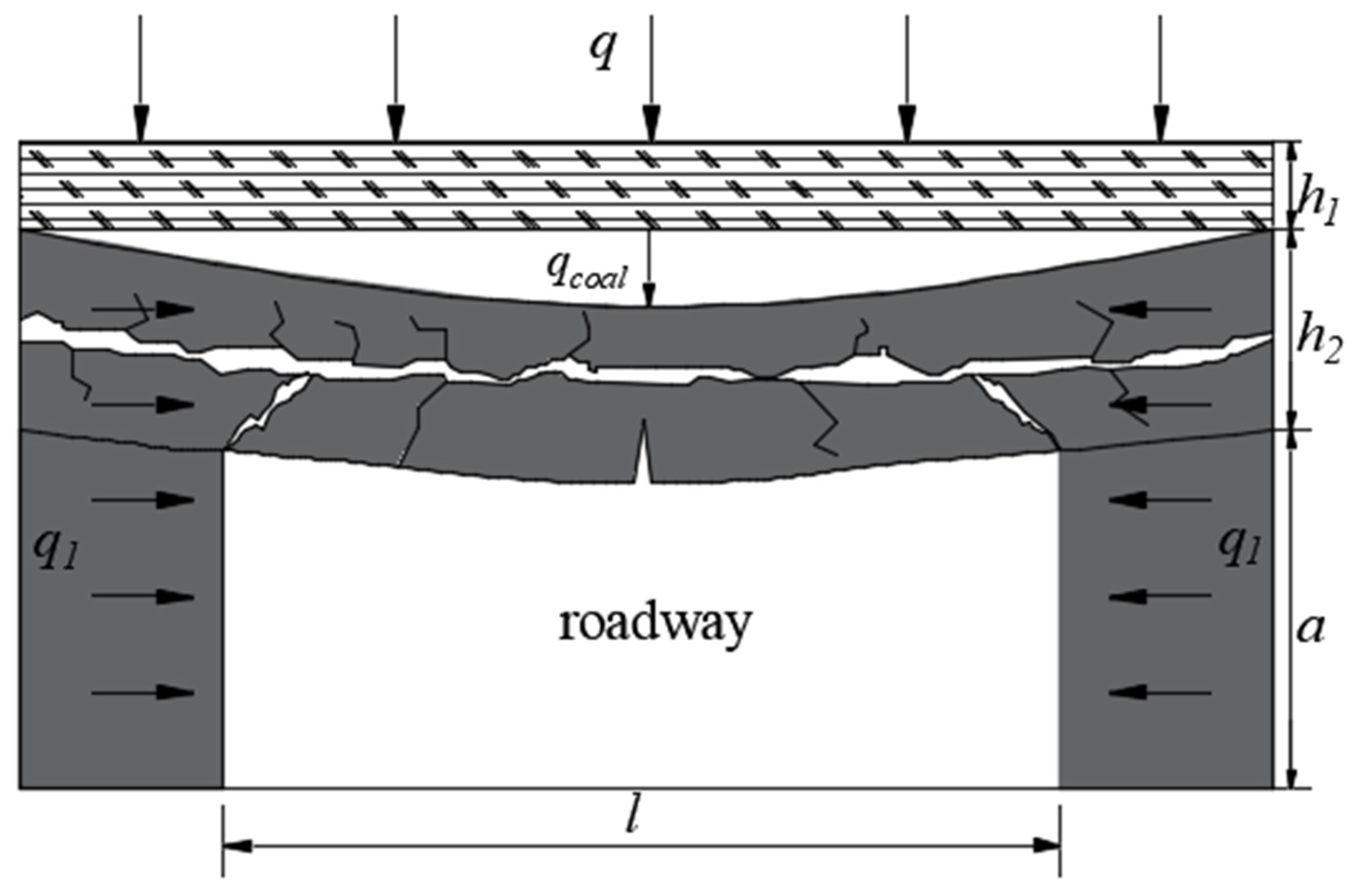

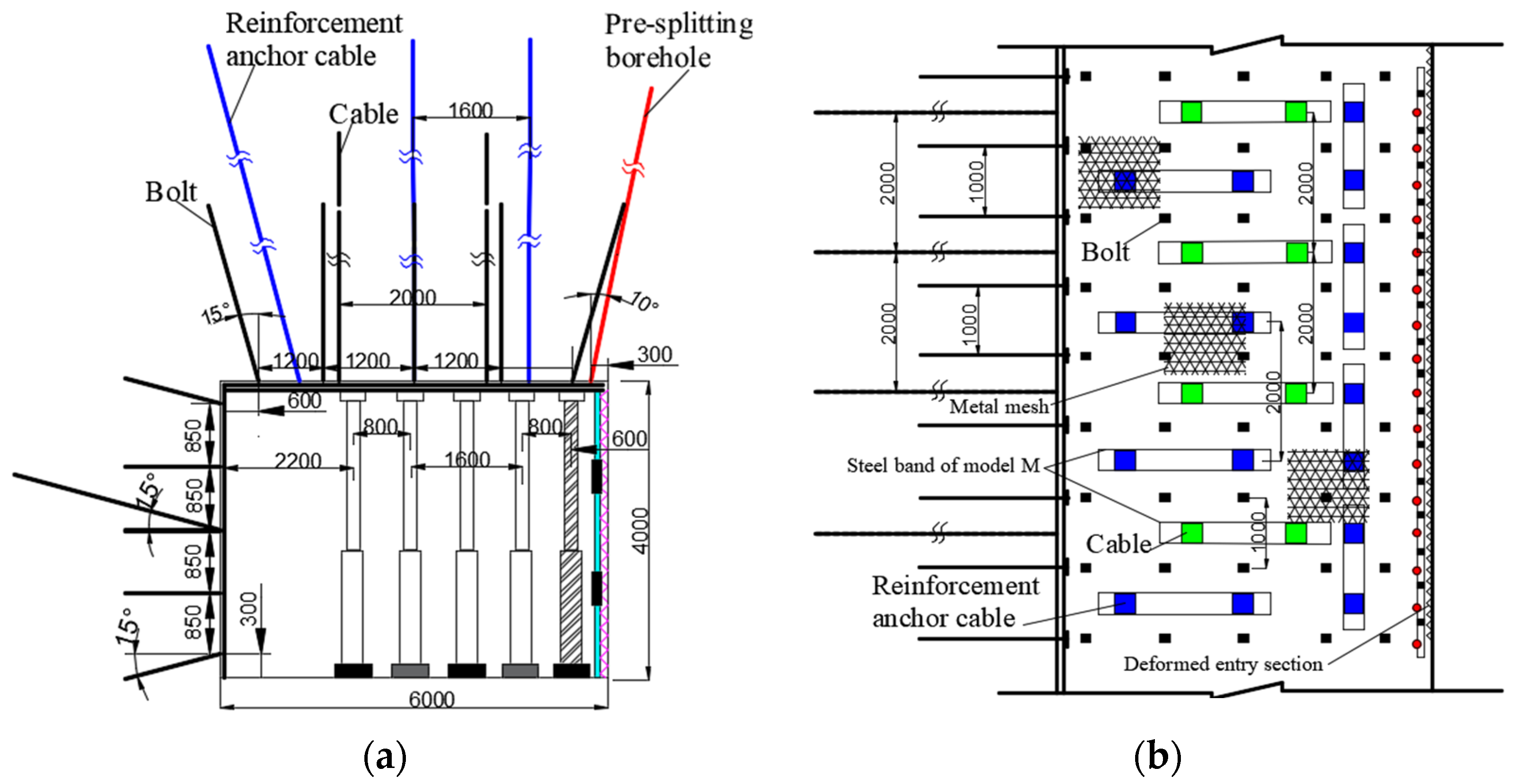
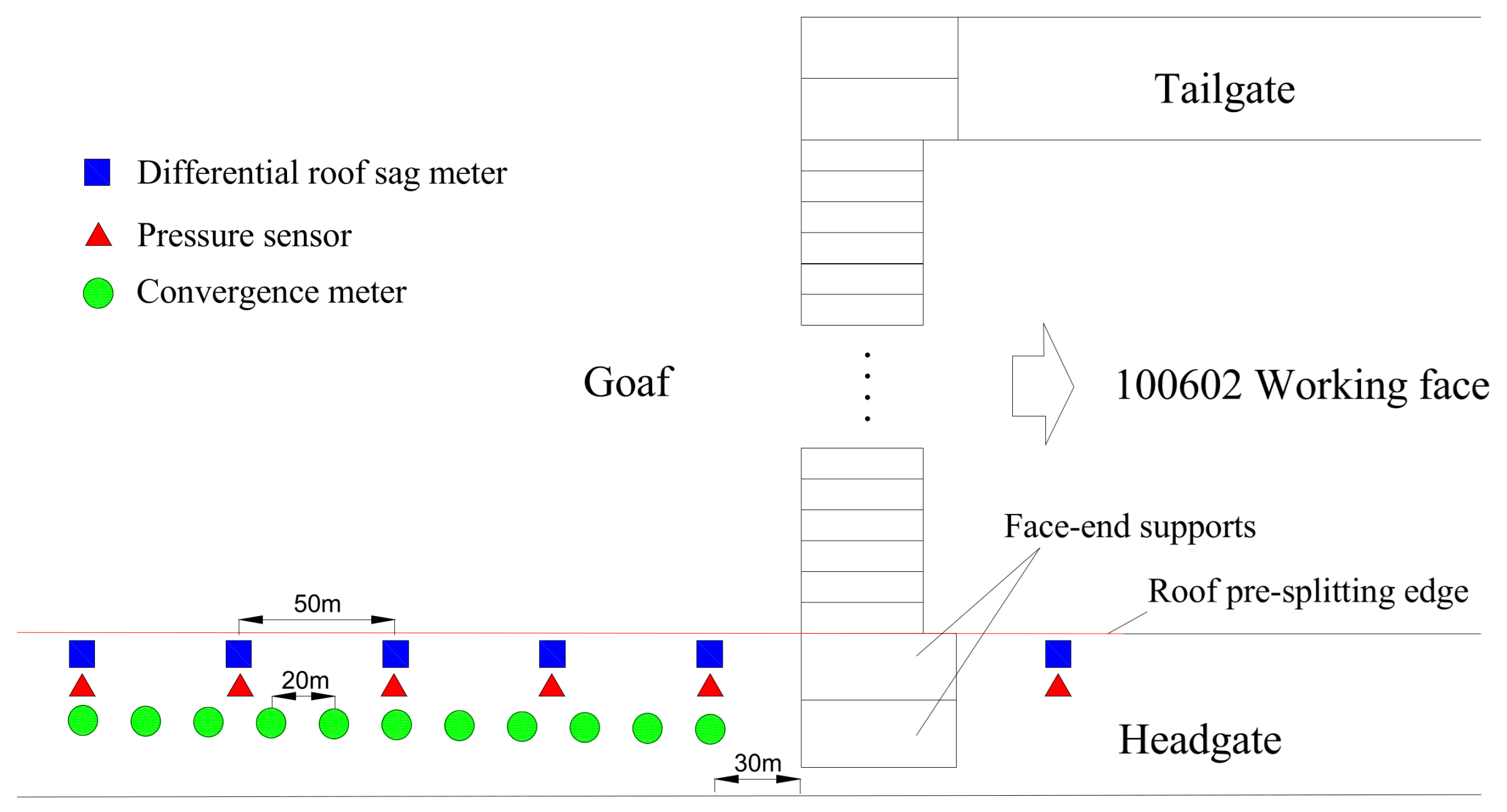
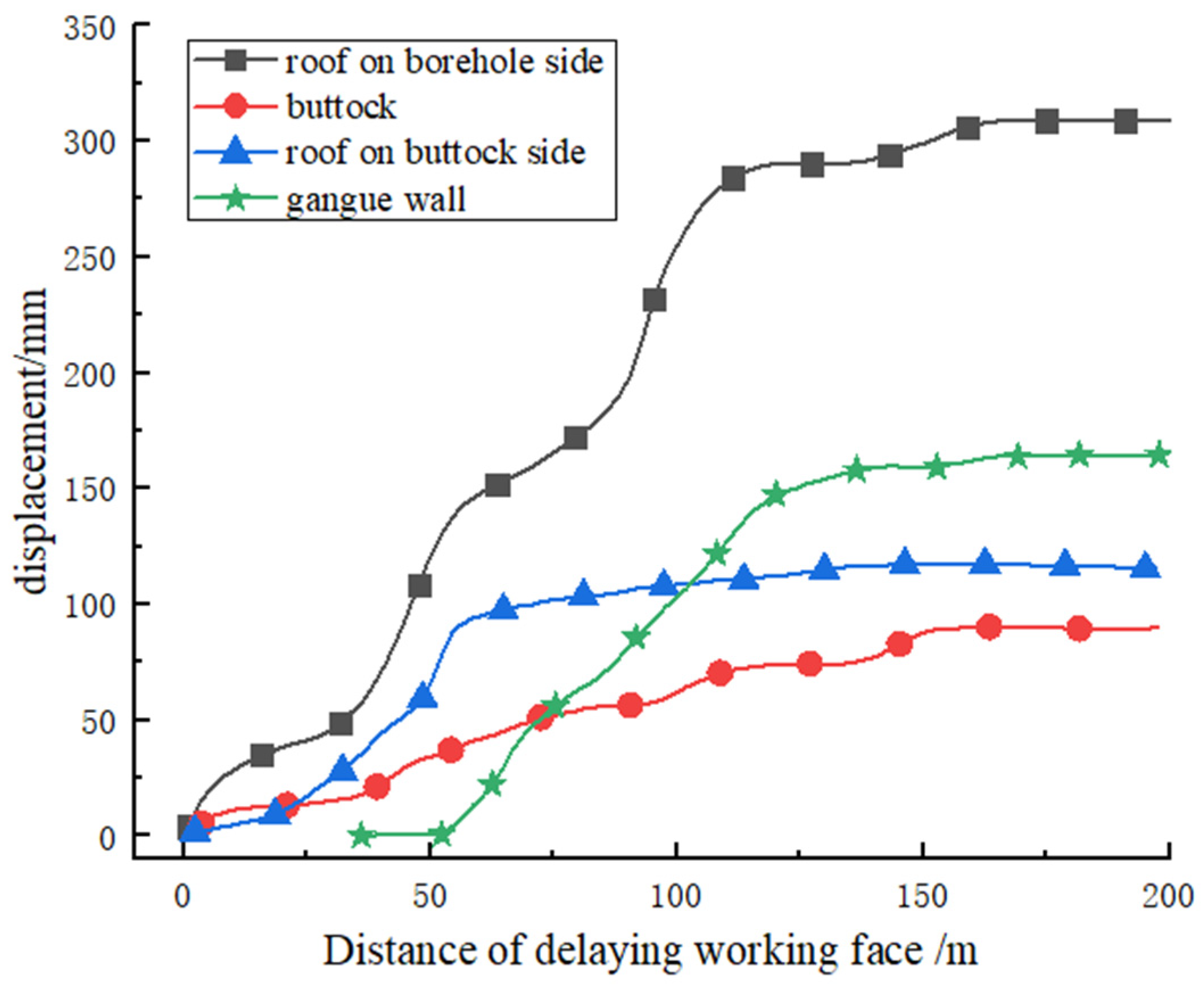
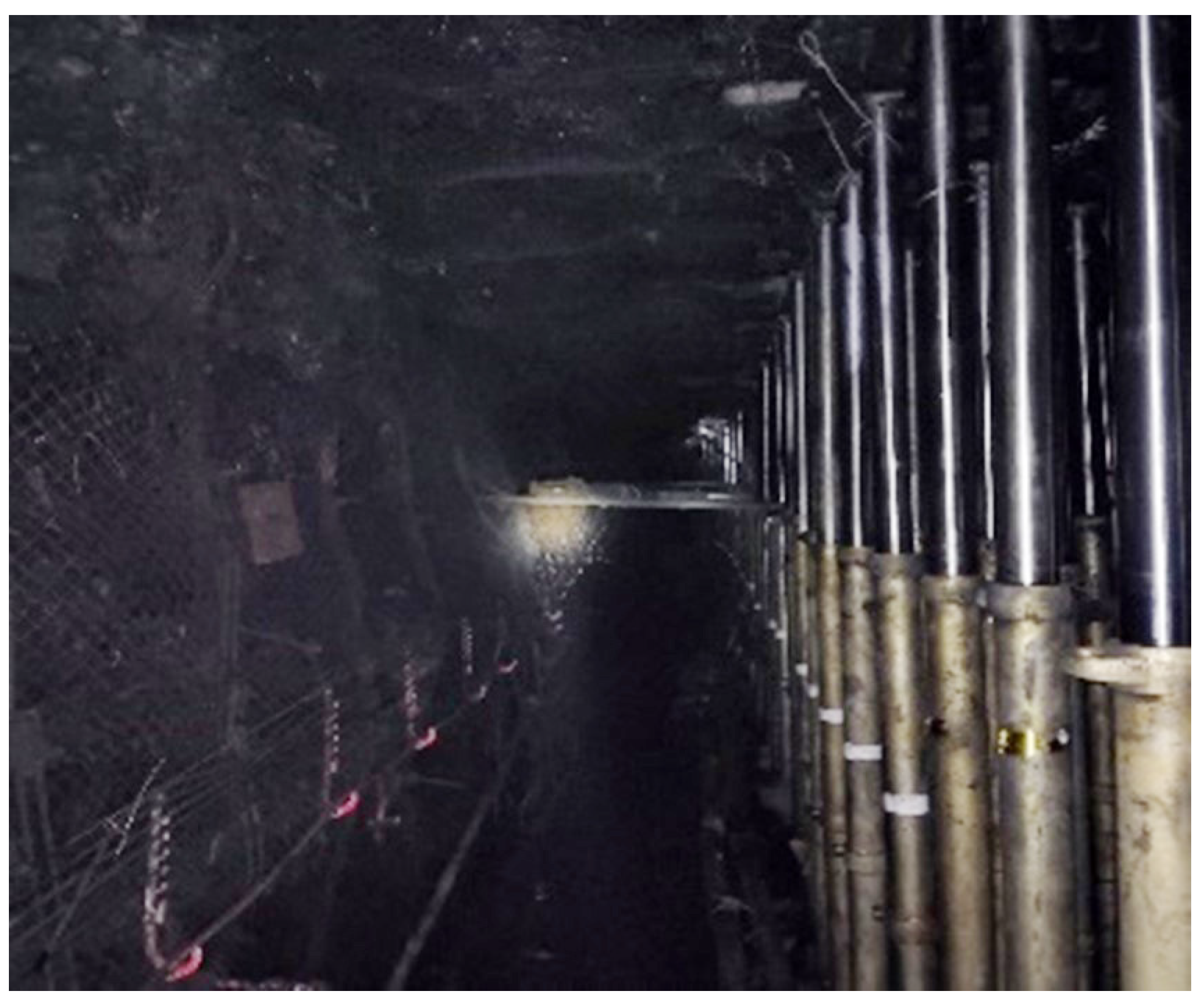
| Lithology | Density/g·cm−3 | Compressive Strength/MPa | Tensile Strength/MPa | Cohesion/MPa | Elastic Modulus/MPa | Poisson’s Ratio | Friction Angle/° |
|---|---|---|---|---|---|---|---|
| Siltstone | 2.57 | 31.58 | 2.88 | 9.32 | 4238 | 0.31 | 30.33 |
| Fine sandstone | 2.60 | 51.79 | 5.65 | 13.00 | 5836 | 0.24 | 27.14 |
| Mudstone | 2.52 | 30.10 | 3.82 | 5.01 | 3813 | 0.26 | 28.20 |
| Limestone | 2.54 | 40.83 | 4.45 | 8.02 | 3023 | 0.36 | 34.53 |
| Mudstone | 2.53 | 34.77 | 3.78 | 4.78 | 3865 | 0.30 | 27.56 |
| No. 10 coal | 1.45 | 11.00 | 0.90 | 3.10 | 1100 | 0.28 | 28.00 |
| Mudstone | 2.53 | 34.77 | 3.78 | 4.78 | 3865 | 0.30 | 27.56 |
| Fine sandstone | 2.60 | 51.79 | 5.65 | 13.00 | 5836 | 0.24 | 27.14 |
| Lithology | Pb_emod/GPa | Pb_kratio | Pb_ten/MPa | Pb_coh/MPa | Pb_fa/° |
|---|---|---|---|---|---|
| Siltstone | 0.47 | 1.35 | 10 | 30 | 20 |
| Fine sandstone | 0.44 | 1.20 | 23 | 54 | 28 |
| Mudstone | 0.50 | 1.25 | 18 | 14 | 30 |
| Limestone | 0.49 | 1.00 | 25 | 36 | 22 |
| Mudstone | 0.48 | 1.40 | 14 | 12 | 30 |
| No. 10 coal | 0.28 | 2.00 | 2 | 8 | 16 |
| Mudstone | 0.48 | 1.43 | 16 | 13 | 32 |
| Fine sandstone | 0.43 | 1.22 | 24 | 55 | 27 |
| Factor Scheme Number | Height of Roof Cutting/m | Borehole Dip Angle/° | Mining Height/m | Coal-Seam Thickness/m |
|---|---|---|---|---|
| 1–3 | 12, 16, 20 | 10 | 4 | 8 |
| 4–6 | 16 | 0, 10, 20 | 4 | 8 |
| 7–9 | 16 | 10 | 3, 4, 5 | 8 |
| 10–12 | 16 | 10 | 4 | 6, 8, 10 |
Disclaimer/Publisher’s Note: The statements, opinions and data contained in all publications are solely those of the individual author(s) and contributor(s) and not of MDPI and/or the editor(s). MDPI and/or the editor(s) disclaim responsibility for any injury to people or property resulting from any ideas, methods, instructions or products referred to in the content. |
© 2023 by the authors. Licensee MDPI, Basel, Switzerland. This article is an open access article distributed under the terms and conditions of the Creative Commons Attribution (CC BY) license (https://creativecommons.org/licenses/by/4.0/).
Share and Cite
Yang, Y.; Gao, P.; Zhang, C.; Wang, C. Numerical Investigation of the Influence of Roof-Cutting Parameters on the Stability of Top Coal Gob-Side Entry Retaining by Roof Pre-Fracturing in Ultra-Thick Coal Seam. Energies 2023, 16, 4788. https://doi.org/10.3390/en16124788
Yang Y, Gao P, Zhang C, Wang C. Numerical Investigation of the Influence of Roof-Cutting Parameters on the Stability of Top Coal Gob-Side Entry Retaining by Roof Pre-Fracturing in Ultra-Thick Coal Seam. Energies. 2023; 16(12):4788. https://doi.org/10.3390/en16124788
Chicago/Turabian StyleYang, Yongkang, Peipeng Gao, Chao Zhang, and Chenlong Wang. 2023. "Numerical Investigation of the Influence of Roof-Cutting Parameters on the Stability of Top Coal Gob-Side Entry Retaining by Roof Pre-Fracturing in Ultra-Thick Coal Seam" Energies 16, no. 12: 4788. https://doi.org/10.3390/en16124788
APA StyleYang, Y., Gao, P., Zhang, C., & Wang, C. (2023). Numerical Investigation of the Influence of Roof-Cutting Parameters on the Stability of Top Coal Gob-Side Entry Retaining by Roof Pre-Fracturing in Ultra-Thick Coal Seam. Energies, 16(12), 4788. https://doi.org/10.3390/en16124788






